Ultimate 3 Days in Penang Itinerary Best Street Art, Food & Sites
We have wanted to visit Penang Malaysia for a long time. We were first drawn by the Peranakan history in both Malacca and Penang (Reggie’s family immigrated through Penang on the way to Singapore) and then by the legendary Penang street art. When we finally made it to Penang, we were not disappointed. Georgetown Penang (also called George Town) is the center of it all. Most people spend 3 days on a Penang trip. There are so many things to do (and eat) in Penang that we are including a (bonus) 4 and 5 days in Penang itinerary. If you have less time, you’ll also find a 1- and 2-day itinerary.
This article may contain affiliate links. This means that if you make a purchase after clicking on the link, we may receive a small commission.
Orientation to Penang Travel
Where is Penang?
Penang, located in Southeast Asia, is made up of an island plus part of the Malaysian mainland in the northern west coast of Malaysia. George Town is the center of the tourist attractions and is located on the northeast corner of the island section of Penang. Most people spend their entire time in George Town. We went to the mainland to see the Butterworth art walk, another street art location in Penang.
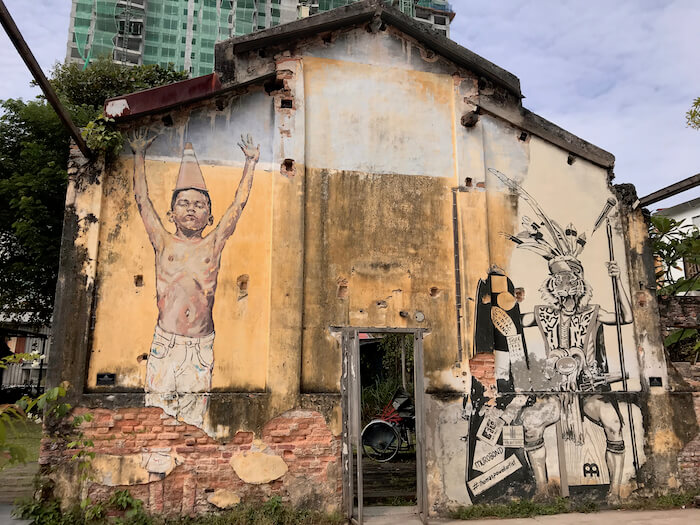
When to Go to Penang
Penang is warm all year round with temperatures ranging from 28°C-30°C (81-82°F). September to November is considered rainy season, but April and May can also have a bit of rain. December to February is high travel season, particularly around Chinese New Year. If you are traveling in August, check the dates for Ramadan as Malaysia is a Muslim country and many things shut down during this holiday. Some places also close during Chinese New Year. Peak tourist seasons are from December to January and June to August.
Entry Requirements and Visa
Citizens of most (170+) countries either do not need a visa or can get one on arrival.
Currency
The Currency is the Malaysian Ringgit (the current exchange rate is US$1 = MYR4). We recommend changing money and have some smaller bills for markets and street food.
Getting there
Penang is easy to get to from the major cities in the region. It is an hour bus ride from Kuala Lumpur, a 90-minute plane ride from Singapore, 2 hours from Ho Chi Minh, 3 hours from Hanoi, and less than 2 hours from Bangkok.
The Penang Airport is 20 KM (12 miles) from the center of George Town. In traffic, it could take an hour.
We flew to Penang on Scoot Air, the budget edition of Singapore Airlines. The fare was S$369/2pp (US$274) including check-in bag allowance. In actuality, we need not have paid for checked bags as our carry-ons were within the 10kg weight limit.
Getting around
If you stay in central George Town, Penang is an easy place to walk around. Grab (Asia’s version of Uber) is available and cheaper that the official taxis.
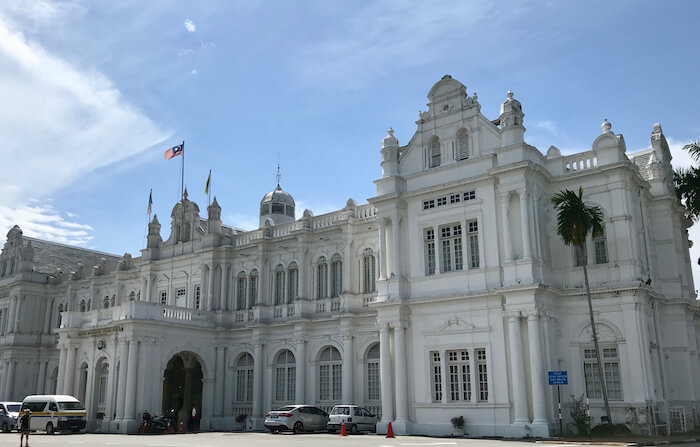
History of Penang
The name Penang comes from the Malay words Pulau Pinang which means “the Island of the Areca Nut Palm.” Penang was inhabited as far back as 5,000-6,000 years ago. From 330 to 1136, Penang was ruled by Hindu Kings. In 1136, the Hindu king converted to Islam and established the Sultanate of Kedah which ruled until the British colonized the city in 1770. Under British rule, Penang, Malacca and Singapore made up the Straights Settlements.
Many Chinese (called Straights Chinese) immigrated from China through Penang and Malacca to Singapore. They became known as Peranakans and they adopted the customs, food and dress of the Malays but not the Islamic religion. Men are known as Baba and women as Nyonya. This created a strong relationship between the three regions, despite their geographic separation.
During WWII, the Japanese occupied Penang. After the war, the British re-captured the area. The Straits Settlements (Penang, Malacca and Singapore) were abolished and Penang became part of Malaya. Many people in Penang opposed this move as they did not see themselves as part of Malaya.
Malaya became independent in 1957. In 1963, Singapore was granted self-governance by the British and combined with Malaya to form the independent country of Malaysia. Two years after Malaysia was formed, Singapore was forced out and became a separate country. The historical and cultural connections between Penang, Malacca and Singapore remain.
Top 18 Things to do In Penang
If you are interested in history and Chinese heritage, street art, temples and mosques, or just wandering the city, you won’t be at a loss for what to do in Penang. There are so many Penang attractions that it is hard to narrow it down to the Top 18. We tried anyway and here is our list.
Chinese & Peranakan Heritage
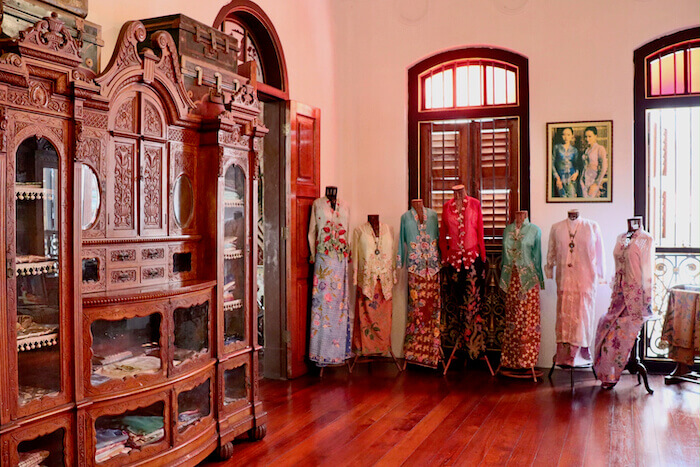
Peranakan Mansion
If you want to understand Peranakan history and culture, the Peranakan Mansion/Museum is one of the best places to visit in Penang. The Mansion was designated a World Heritage site in 2008. It tells the story of a wealthy Peranakan family and the unique blend of Malay and Chinese cultures created in the Straights Chinese settlements (Penang, Malacca and Singapore). We highly recommend taking a free tour to learn about the customs, furnishings, dress and jewelry.
Address & Hours: 29 Church St, Georgetown. Open from 9:30am-5pm (check for Malaysian holidays including Ramadan). Entry Fee: MYR20 or $5USD.
Cheong Fatt Tze House (the Blue Mansion)
The Blue Mansion is a very interesting place in Penang. It was built by Cheong Fatt Tze, one of the most influential Chinese businessmen and a Mandarin (or government official). He rose from rags to riches and was known as the “Rockefeller of the East.”
The mansion has 38 rooms, 7 staircases and 5 courtyards and took 7 years to build. The servants lived across the street in what are now 5 shophouses. After falling into disrepair, the mansion was restored and turned into a hotel with a restaurant, called Indigo.
If you are a Crazy Rich Asian fan, the scene where Rachel challenged Eleanor to a game of mahjong was filmed in one of the courtyards in this mansion.
Address & Hours: 14 Leith St, Georgetown. If you are not staying in the hotel, you can only go inside the mansion during a tour. English tour times are 11am, 2pm and 3.30pm Mondays to Fridays, and only 11am and 2pm on the weekends. Entry fee: MYR18 or $4.50USD.
Khoo Kongsi Clanhouse
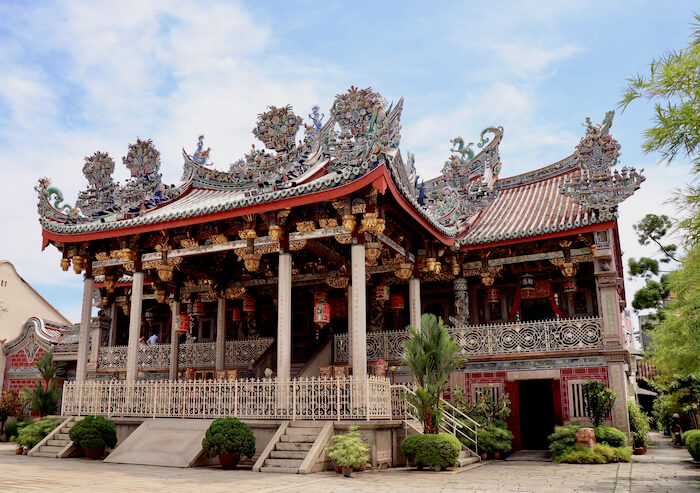
The Khoo Kongsi Clanhouse is one of the main Penang tourist attractions and is well worth visiting to learn more about how the clans lived in Penang.
The Chinese community in Penang was organized according to their dialect group which evolved into the clans. There were 5 major clans in Penang, including the Khoos. They were the elite of the Chinese community in Penang. The clans lived and worked together and provided for the welfare of all members. The Khoo Kongsi clan was one of the wealthiest and has influential descendants throughout Southeast Asia. At the clanhouse, you will see how they lived in the early 1900s. It has an ornate temple, rowhouses and a theater.
Address & Hours: 18 Cannon Square. Open from 9am-5pm daily, (check for Malaysian holidays and Ramadan). Entry Fee: MYR10 or $2.50USD.
Clan Jetties
Life by the ocean in Penang was also organized by Chinese clans. Originally the jetties were used for the mooring of boats and unloading of goods, organized along Hokkien clan lines. Later on, shelters and houses were built on the jetties. Five clan jetties remain and are part of the UNESCO Georgetown heritage designation.
There are still people living in the jetties and there are shops for souvenirs, drinks or other treats. You can see YC Yip’s Folklore by the Sea mural against one of the houses on stilts.
Address & Hours: Pengkalan Weld Quay, Georgetown near the ferry terminal. Free to enter.
Religious Sites
There are many temples, mosques and other religious sites among the Penang points of interest. The most well-known temples are Wat Chaiya Mangalaram, Dhammikarama Burmese Temple, Kek Lok Si and the Snake Temple. You will also find many smaller temples as you wander the streets—we went into a number of them.
Wat Chaiya Mangalaram
Wat Chaiya Mangalaram is a Thai Buddhist Temple founded in 1845. It is across the street from the Dhammikarama Burmese Temple and the two temples are very different. Wat Chaiya has one of the largest reclining Buddhas in Malaysia (33M or 108 Feet long).
Address & Hours: 17 Lorong Burma, Georgetown. Open from 6am-5.30pm. Free to enter.
Dhammikarama Burmese temple
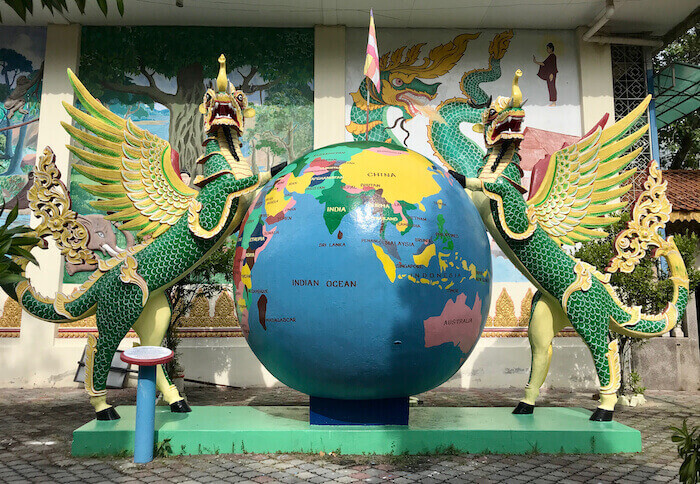
Built in 1805, Dhammikarama is the oldest Burmese Buddhist Temple in Malaysia. We found Dhammikarama Temple to be very serene with a wishing pond and Bodhi tree. Don’t miss the Panca Rupa guardians—a combination of a lion, elephant, fish, horse, deer and the wings of the Garuda. These creatures are said to be the protectors of the world.
Address & Hours: 24 Lorong Burma, Georgetown. Open from 6am-5.30pm. Free to enter.
Kek Lok Si Temple
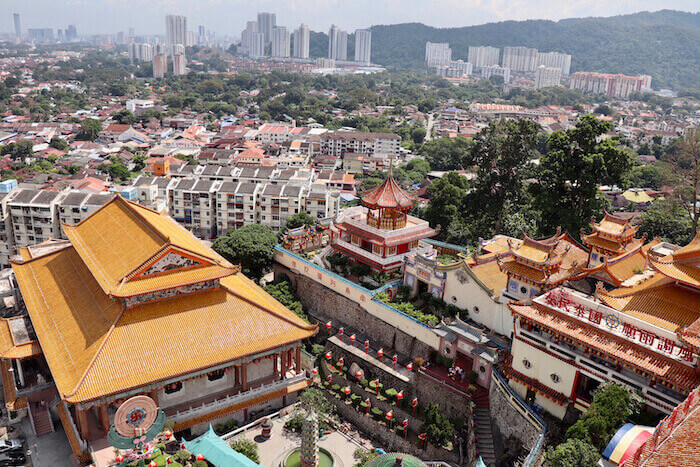
Built between 1890-1905, Kek Lok Si is the largest Buddhist complex in Malaysia. The complex includes a seven-story pagoda. It is 195 steps to the last level and another 15 steps to the pinnacle. There are Buddhas on every floor and great views from the top. The Pagoda has three styles of architecture (Chinese on the first few floors, Thai in the middle and Burmese at the top). Cheong Fatt Tze (see Blue Mansion above) was one of the five businessmen that funded the construction.
Address & Hours: 1000-L, Tingkat Lembah Ria 1, 11500 Ayer Itam. The best way to get there is by a GRAB car. There’s no fee to enter the temple, but it costs MYR2 to climb up the pagoda.
Snake Temple
There are many other temples to see in and around Penang. If you are a fan of the Amazing Race, you probably saw the Snake Temple during season 16. The temple is well known for the snakes that are in and around the temple. They have reportedly been de-venomed, but not defanged. We elected not to visit it.
Address & Hours: Jalan Sultan Azlan Shah in Bayan Lepas Industrial Park) is located in the South Western part of the Penang Island. Free to enter.
Kuan Yin Teng or Goddess of Mercy Temple
The Goddess of Mercy Temple is Penang’s oldest Taoist Temple. It is dedicated to Guan Yin, the Goddess of Mercy and has a distinctive red roof. Founded in 1786, it was originally devoted to the sea deity Mazu.
Address & Hours: 30 Jalan Masjid Kapitan Keling. Free to enter.
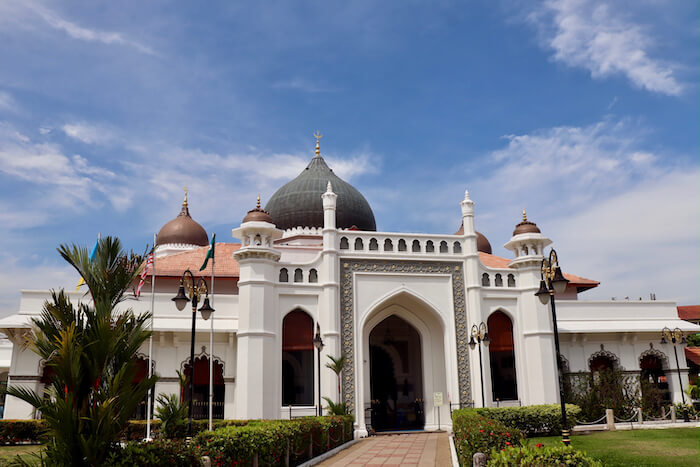
Mosques
Malaysia is a majority Muslim country and there are many mosques in Penang. The five most well-known mosques in Penang are: Masjid Negeri (the State Mosque of Penang), the Penang Floating Mosque, Masjid Abdullah Fahim, Masjid Lebu Acheh (Achene Street Mosque) and Masjid Kapitan Keling.
Kapitan Keling Mosque (Masjid Kapitan Keling)
Masjid Kapitan Keling is the oldest Mosque (dating to 1801) in Penang and the only one that provides guided tours for non-Muslims. It serves the Tamil Muslim community.
We took a tour and then sat down for a conversation with Kamarudin Abdullah, founder and President of the Islamic Propagation Society International. He was involved in opening the Mosque to non-Muslim visitors. He spoke to us about his commitment to bridge-building with the non-Muslim community and Islam as a peaceful religion. At the same time, he is associated with Muslim leaders that are fundamentalist in their approach and attitudes towards women, LGBTQ+ and other communities. We will post this video at a later date.
Address & Hours: 14 Jalan Buckingham. Make sure to be properly attired. Women must wear long pants, shoulders covered and a hat. There are robes loaned by the Mosque for visitors that do not meet these requirements.
Jewish Cemetery
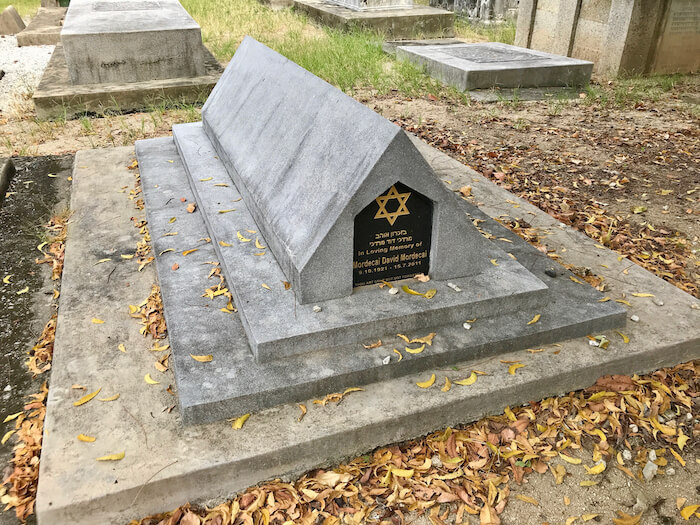
The Jewish Cemetery in Penang is a solemn place to visit. It is all that is left from the very small Jewish community that lived in Penang from the early 1800s.
The first Jews came from the Middle East (Persia, Baghdad), then India, later China and Russia. In 1805, the Penang Jewish Cemetery was established. It is believed to be the oldest Jewish cemetery in Southeast Asia. Penang had one synagogue from 1929-1976. The last funeral took place in 2011.
During the Japanese occupation during WWII, many of the Jews evacuated to Singapore and from there, many left for Israel, Australian, the United States and other places.
An Indian family that has served as the caretaker of the site for 5 generations. Sevla, the Tamil caretaker, immediately came to the gate when we walk in and showed us around the cemetery.
Address & Hours: Jalan Zainal Abidin (formerly Yahudi or “Jew” Road) between Burmah and Macalister Road. You have to find the gate to enter. Free to enter.
Street Art Georgetown
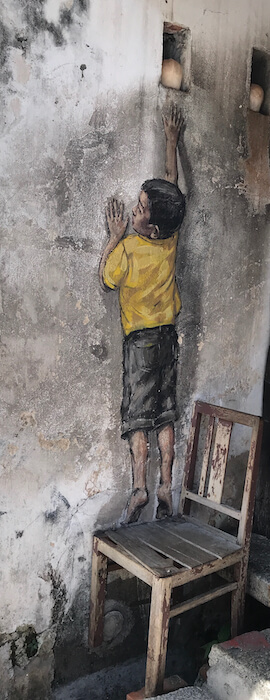
Street art in Asia is very varied by country. In Phnom Penh, street art is just emerging. In Hanoi, interactive street art is a big attraction. Penang has one of the longest histories of street art in Asia with a lot of iconic and famous murals. Street art in Penang is on everyone’s list of things to do. And, there is a lot. You can find it as you walk about or do an afternoon of Georgetown Penang Street Art Hunting. Julia Volchkova and Ernest Zacharevic are two of the most known artists, but there are many more. Here is a deeper look at the Best Penang Street Art.
Street Art Georgetown
As you walk around art is everywhere. Lebuh Armenia in Old Town, Lebuh An Quee, Chulia Street and by the Chew Jetty are just a few of the places to see a Penang mural. In addition to Georgetown Penang street, you can also find some excellent Penang wall murals at the Hin Bus Depot and the Butterworth Street art walk. Below are some suggestions. We will be doing a full post on Penang street art next week.
Hin Bus Depot
The Hun Bus Depot was originally built in 1947. It served as a bus depot until Tan Shih Thoe, the current owner took over and transformed this into a community project and Penang art gallery that showcases local artists’ work. There are murals painted by One Two, Ernest Zacharevic, Rone, Alex Face and others.
If you happen to be in Penang on Sundays, don’t miss the pop-up stalls selling handicrafts, food and other items. We were there during A Collector’s Show and had an opportunity to view works from the private collection of Mr. Tan. The gallery features ongoing exhibitions, film screening, garage sales and charity markets.
Address & Hours: (31A, Jalan Gurdwara, gallery hours are 12-8pm Mondays to Fridays, and 11am-8pm on the weekends, free)
Butterworth Street Art Walk
If you’re adventuresome, take a GRAB to Butterworth to see the street art walk. The street art walk is several blocks of colorful and interactive murals, some of which are newer and in much better condition than the more famous murals in George Town.
Address & Hours: The side of Lodge 18 Hotel in Lorong Bagan Luar 1, Butterworth. Free to enter.
Marking Georgetown Sculptures
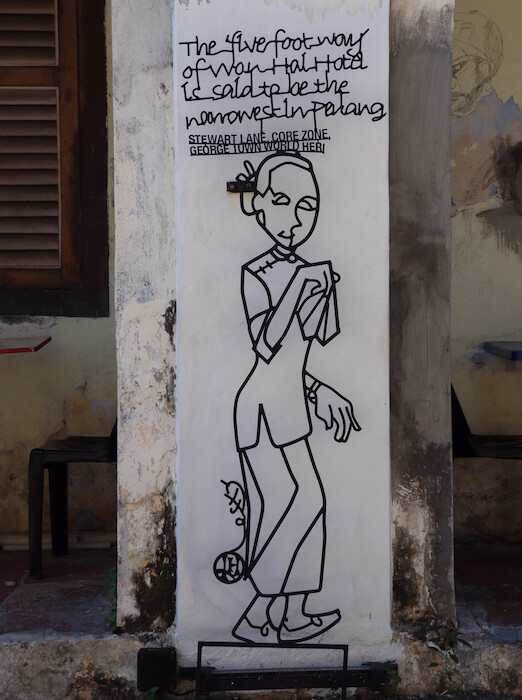
As you wander the streets, you will see the steel rod sculptures spread around the city. These sculptures tell the story of Penang. There’s a Marking Georgetown map that shows you the exact locations. One features Jimmy Choo (the shoe designer) and shows his humble beginnings as a shoe apprentice. Another shows the smallest “5 foot way” in the city.
Historical Sites
Fort Cornwallis
Fort Cornwallis was originally built by the British East Indian Company in the late 1700s. The fort was rebuilt in the early 1800s and made more permanent. It is the largest standing fort in Malaysia. The Fort has a chapel and the Seri Rambai cannon cast in 1603. It’s a good site for families and children.
Address & Hours: Lebuh Light, Georgetown. Open from 9:00 am to 5:30 pm. Entrance Fee: MYR20 (US$5)
Penang Hill
Penang Hill is one of the best-known places to go in Penang. It offers spectacular views, nature trails, a large variety of birds and a climate that is noticeably cooler than the heart of George Town. To get to the top, you can take the Penang Hill Railway (30-minute ride) or an 8KM hike (an hour uphill). At the top, there is a Hindu Temple and a Mosque, a post office and a small hotel.
Address & Hours: Ayer Itam (6KM from George Town). Trains operate from 6:30 am to 11 pm. Train Fee (round trip): MYR30 (adults) and MY15 (children).
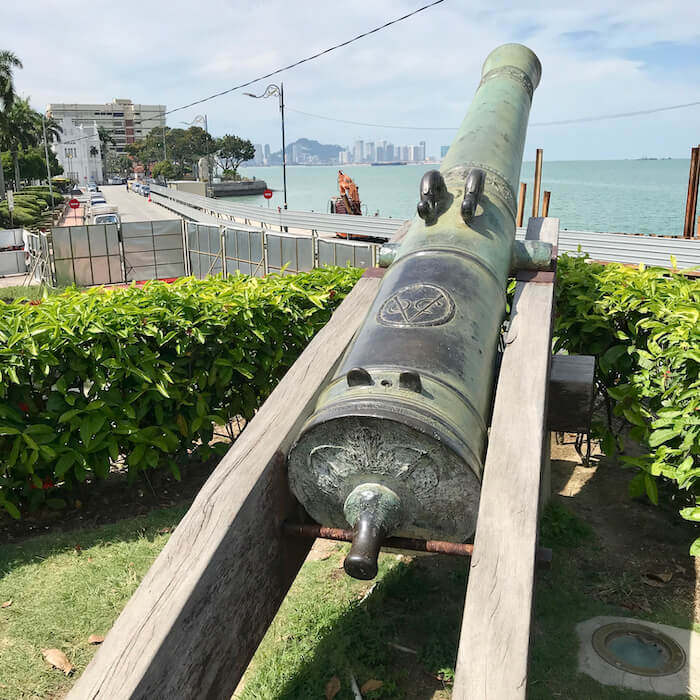
Wander the Streets
In our opinion, the best part of travel is wandering. And, Penang is a great place for that. We discovered the Campbell market, the glass museum, Little India. You can’t go wrong in Penang.
Best Penang Itinerary 3 Days and More
Three days in Penang will allow you to just scratch the surface of this vibrant city. There are so many things to see in Penang. In this Penang Trip Itinerary, we will tell you what to do for a trip between 1 and 5 days. If you’re like us, you’ll fall in love with Penang and want to go back more than once.
Itinerary for 1 Day
A Penang Day Tour Itinerary will force you to make some hard decisions about what to do, see and eat. There are simply too many Penang tourist spots to see in one day. Here are our best suggestions for getting a taste of all that Penang offers:
Peranakan Museum
Explore George Town
Street Art and Marking George Town Sculptures
Penang Hill at Sunset (and Botanic Gardens)
The Clan Jetties
Itinerary for 2 days
In two days in Penang, you will be able to get a better sense of Penang–it’s Peranakan history, the Street food and a Mosque or Temple.
Day 1 Itinerary plus:
The Blue Mansion
Kapitan Keling Mosque (or Kek Lok Si Temple)
Khoo Kongsi Clan House
Chulia Street Night Market
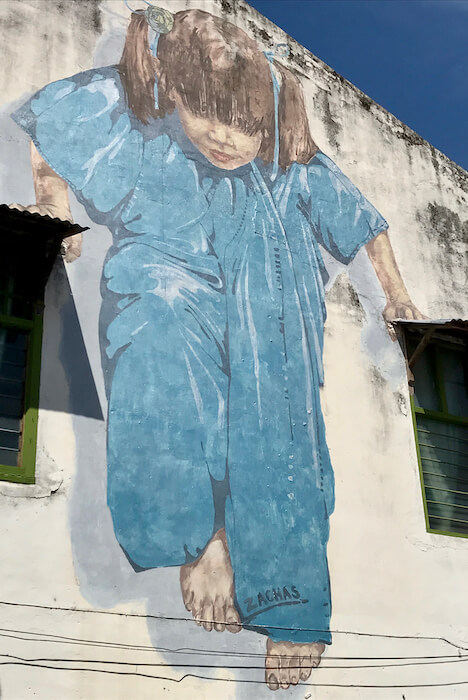
Itinerary for 3 days
Three days in Penang will give you a chance to dive deeper into street art and temples.
Day 1-2 Itinerary plus:
Wat Chaiya Mangalaram
Dhammikarama Burmese Buddhist Temple
Hin Bus Depot
Itinerary for 4 days
Four days in Penang is ideal. You will be able to see all of the suggestions above and then take a trip to the mainland to see the Butterworth Street Art Walk. You’ll also have time for Kek Lok Si Temple.
Day 1-3 Itinerary plus:
Butterworth Street Art Walk
Lunch in Butterworth
Kek Lok Si Temple
Itinerary for 5 days
With 5 Days in Penang, you will have time for a day trip to Langkawi. If you don’t want to go to Langkawi, then stay in the city and get to know it more. Take some time to see the Jewish cemetery if that interests you. Wander the street or go down to City Hall and walk the promenade. Take a cooking class or do one of the things not yet on our list.
Day 1-4 Itinerary plus:
Jewish Cemetery (Optional)
Hin Bus Depot
Langkawi Day Trip
See City Hall
Eating in Penang Georgetown
One of the best things about Penang is the food. From the Chulia Street Market to restaurants like Tek Sen, the food is varied and interesting. We wished we had more nights to sample many more restaurants and food stalls.
Street Food
Chulia Night Market is an unassuming set of food stalls on Chulia Street. Every night, the vendors arrive and set up for the evening. You can’t go wrong at any of the stalls. We had wonton mee and satay on our 1st night in Penang. And, Apom (coconut pancakes) almost every night. The Gurney Drive Hawker Center has a good reputation too.
Teksen Restaurant
Teksen is the best Chinese restaurant in Penang. A very busy place that spills out onto the sidewalk, the food is anything but unassuming. Delicately flavored and seasoned, we would have gone there for every meal if we could. The queuing starts early for lunch and dinner. Arrive too late and you might miss out.
Address and Hours: 8-20 Lebuh Carnarvon (hours are 12-3pm, last order 2.30pm, 6pm-9pm), be prepared for lines
What The Duck
What the Duck serves…well, duck. Perfectly cooked and seasoned duck. And, much more. We had the four-course set dinner. The duck confit salad had a very generous portion of duck. The potato/vegetable soup was perfection. The Balinese spicy duck was crispy, moist and flavorful.
Address and Hours: 40 Jalan Nagore 12-2:30 6-10:30
Coffee Atelier
We stayed at Coffee Atelier and had breakfast there every morning and one lunch on our last day. Breakfast is huge and they cook local foods as well as western. The eggs and fruit are fresh and well cooked. They also make salads and crepes for lunch. The service is excellent and the food simple and delicious.
Address: 55 Lorong Stewart
Nonya House
We stumbled upon Nonya House when the place that we wanted to go was closed and we were looking for a traditional Nonya restaurant. The Tau Ewe Bak (Braised Pork in Soy Sauce) and Green Dragon Vegetables were both very good.
Address: 2 Chulia Street
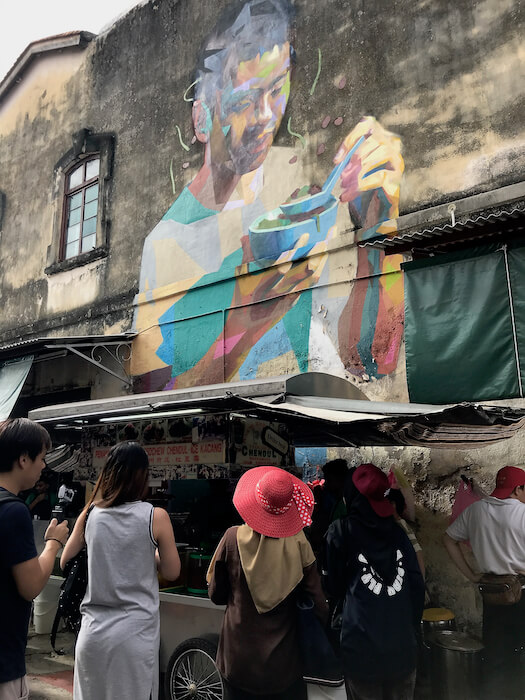
Teochew Chendol
Teochew Chendol is one of the most famous places to have Chendol in Penang. It is easy to find on Lebuh Keng Kwee as it is right under a huge mural by Canadian street artist Emmanuel Jarus. We thought the chendol was just okay.
Address: 27 Jalan Penang
Yeap Noodles
Yeap is a local noodle shop with very good reviews. The noodles were good but didn’t blow us away. The spicy clam noodles are very spicy, with a generous portion of clams. The Loh Bak was very good. Yeap Noodles is not far from Chulia Street Hawker so that is another alternative in this area.
Address: 227 Chulia Street
Leith Street Hawker Center (Near the Blue Mansion)
There is a large hawker center on Leith Street. There are many food stalls with all kinds of Malaysian food. We sampled the wares from Kimpo Roast Duck and East Coast Seafood. We topped that off with a peanut dessert from Ban Jiang Kuih. The stalls are mainly opened at night for dinner.
Auntie Gaik Lean
We tried to go to Auntie Gaik Lean twice but it was closed both times. We were disappointed to not be able to eat at Auntie Gaik Lean’s (1 Bishop Street). It is considered to be one of the best Nonya/Peranakan restaurants in Penang.
Aromas Café
We mention Aromas Café because it is a gay-owned restaurant. We did not have a chance to stop by, but many people love the cakes and desserts.
Address: 38A Lebuh Tye Street
Best Hotel in Penang
Okay. We stayed at only one hotel in Penang. We research many before we went. We chose Coffee Atelier, 55 Lorong Stewart, a boutique hotel converted from 5 shophouses into suites with bedroom, a study and courtyard area. Breakfast was included in our room rate of US$100/night. We enjoyed the hotel’s very hearty 4 course breakfast (freshly squeezed orange juice, coffee/tea, bread basket, cereal, fruit salad/yogurt and eggs with bacon/sausage). The staff is friendly and very attentive.
Address: 55 Lorong Stewart
LGBTQ+ in Penang
LGBTQ+ travelers need to be aware that Malaysia has strict laws against LGBTQ rights dating back to the British colonial era. “Gross indecency with another male person” can be punished with caning and a sentence of up to 20 years in prison. Shariah Laws (which only apply to Muslims) forbid sodomy and cross-dressing. Last year, two Malaysian women were caned when they were discovered having sex in a car.
That said, there is a LBGTQ+ scene in Penang with hotels, bars and restaurants that are gay-friendly or gay-owned. The best place for information on LGBTQ+ Penang is Utopia Asia.
Utopia Asia reports that there are a number of LGBTQ+ Friendly hotels in Penang:
G Hotel Gurney (168A Gurney Drive, Georgetown)
G Hotel Kelawai (2 Persiaran Maktab, Georgetown)
Seventy & bar (54 Jalan Chow Thye, Georgetown)
The LGBTQ+ climate in Malaysian and Penang is changing and you will want to doublecheck these hotels before booking.
We spent 5 days in Penang and still were not able to do all of the things that we wanted to do. We still have to visit Penang Hill and the Botanic Gardens, Gurney Drive, the Rainbow Skywalk, the Glass Museum and many other places. And, of course, to eat more of the wonderful food in Penang. We are already making plans to go back.
Interested in Going to Penang? Have any Questions? Leave a Comment.
Travel for Life Now is a participant in the Amazon Services LLC Associates Program, an affiliate advertising program designed to provide a means for sites to earn advertising fees by advertising and linking to amazon.com. Amazon and the Amazon logo are trademarks of Amazon.com, Inc. or its affiliates.
Please Pin and Share
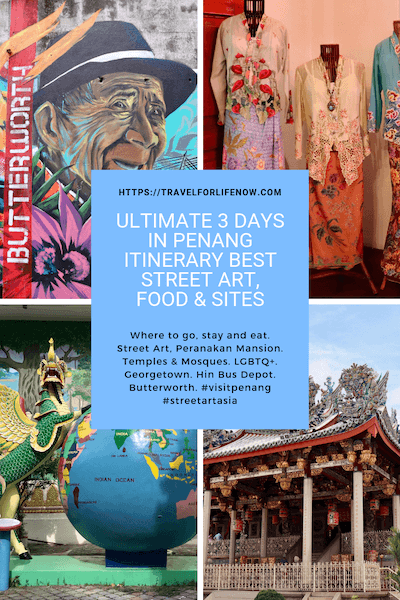

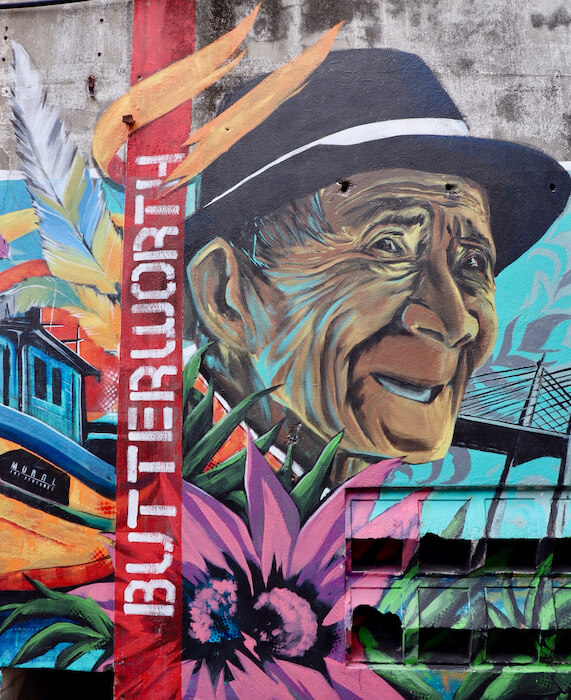
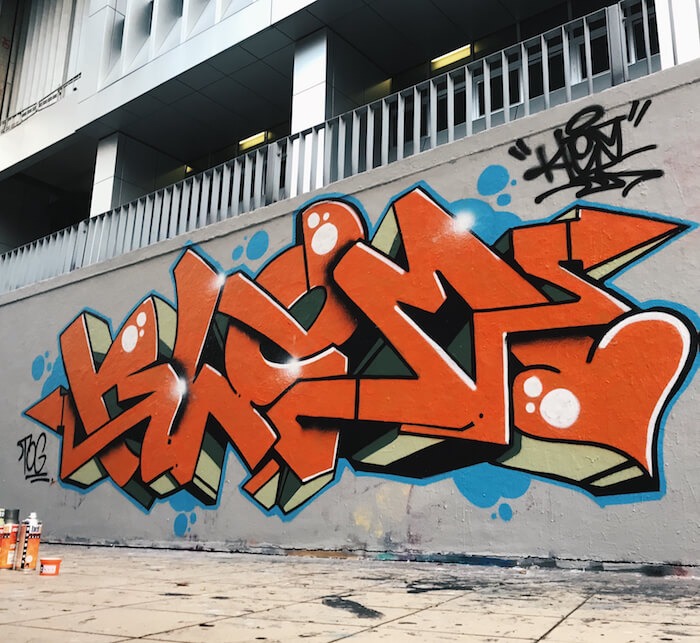
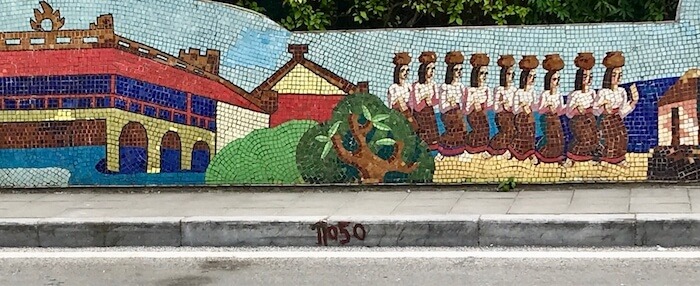
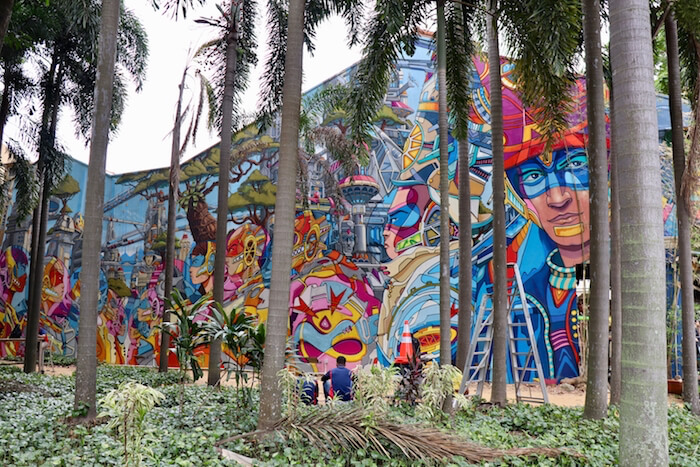
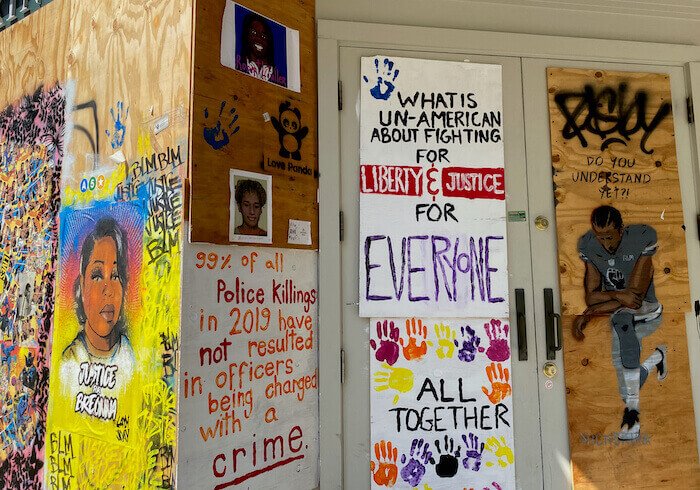
What a beautifully detailed post and what lovely street art too. Thanks for sharing.
Thanks for all of the tips. I love finding street art so this art looks amazing. I love the little boy reaching up. Malaysia is so close to us here in Australia and it’s still on our list of places to visit.
Thank you for teaching me so much about a country I know so little about!
What an amazing journey you had there in such an under reported on country!
This is such a thorough post, it’s a great resource for anyone going to Penang, and I’d be jealous of them going….I haven’t been there for about 30 years! I’d love to go back.
Thanks. Hope you go back. It’s a place I want to go back to again.
George Town is one of my favorite cities not only in Malaysia but in the whole world. The art, the food, the….everything! The rest of the peninsula is nice, too, but George Town….nothing beats this treasure box!
Renata,
Thanks for your comments. George Town is a wonderful place. Glad you enjoy it too.
Sue